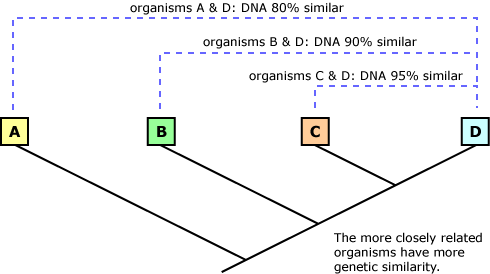Many aspects of endosymbiosis still aren’t understood. For example, how did the first endosymbiont get inside its host? Was the host trying to eat the endosymbiont? If so, why wasn’t the endosymbiont digested? Or was the endosymbiont trying to infect and exploit the host, the way the x-bacteria originally invaded their amoebae hosts?
We might get closer to answering these questions if we knew what species of bacteria came together to make the original eukaryotic cell. Biologists are in the process of figuring this out using evidence provided by comparing the gene sequences of different organisms. In general, the more similar two organisms’ genes are, the more recently their two lineages split apart from one another. If two organisms have been evolving separately for a very long time, and have a distant common ancestor, they are likely to have evolved lots of differences between their gene sequences. So by comparing the genetic sequences of different organisms, biologists can piece together their family tree — who is related to whom.
Biologists have even studied the DNA in mitochondria to figure out how they are related to free-living bacteria. These studies have shown, first, that all mitochondria are descended from one original mitochondrion — that is, endosymbiosis of a mitochondrion only happened once — and second, that mitochondria are most closely related to a bacteria called Rickettsia prowazekii. This parasitic bacterium causes epidemic typhus and is primarily transmitted through bites of animals such as fleas.
As DNA sequencing projects decode more genomes letter by letter, we are learning that eukaryotic “host” cells have a lot in common, genomically speaking, with the strangest, least-understood domain of life: the Archaea. These prokaryotes went completely undiscovered until 1977 because they live in such extreme environments as Antarctica, the Dead Sea, deep-sea vents, hot springs, and sewage sludge. Yet one of them may have been the first endosymbiotic host, and our own ancestor.
Organisms that like extreme conditions are called “extremophiles,” and Archaea are some of the best. Certain species of Archaea live in solutions that are more acidic than vinegar. Others survive in environments that are as basic as ammonia. If you stuck your arm into the homes of some extremophiles, you’d blister and burn your skin right off! Archaea are most famous for tolerating incredible heat — many species live at temperatures above the boiling point of water! How do they survive, when their cells are made of membranes, proteins, and DNA, just like ours? Archaea, and other extremophile organisms, make specialized salts and proteins. Like antifreeze in a car radiator, these compounds keep the cell’s metabolism from freezing up or breaking down, even when conditions outside get hostile. Archaea demonstrate that even billions of years ago, when volcanic Earth was boiling hot, life could have existed. In fact, if life is ever found on other planets in our solar system, it may well resemble extremophiles like the Archaea.

